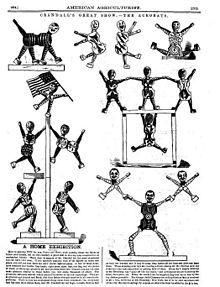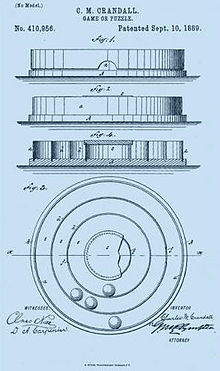- Charles Martin Crandall
-
Charles Martin Crandall Born May 30, 1833
Montrose, PennsylvaniaDied June 25, 1905 (aged 72)
Waverly, New YorkOccupation Inventor and toy-maker Spouse Susan ELizabeth Kress Children Fred, Benjamin, Jesse, Fanny Crandall Parents Asa Crandall
Matilda SaundersCharles Martin Crandall (May 30, 1833 – Jun 25, 1905) was an American inventor and toy-maker. He was best known for various toy blocks, "Crandall's Acrobats", "Noah's Dominoes", "Illuminated Pictorial Alphabet", "District School", "Menagerie", "Pigs in Clover" game and numerous other games and wooden toys such as wooden trains with interconnecting cars. Crandall began working in his father's woodworking and furniture factory in Covington, Pennsylvania and at the age of twelve began inventing toys.[1] When his father died in 1849, Crandall took over the factory at age sixteen.
Contents
Crandall's Blocks
By 1866 Crandall moved the company to Montrose, Pennsylvania and was into the manufacturing of croquet sets. He experimented with fastening the corners of boxes by using grooves and tongues instead of nailing. As his sons were convalesing from scarlet fever, he took some pieces home and his children built various structures such as a house, bridge and fence from them. His children's physician saw the blocks and ordered some. As Crandall would later say, this "was the first sale of the famous Crandall's Building Blocks."[2] In order to sell the blocks, rather than go to jobbers or dealers, Crandall went to P.T. Barnum. Mr. Barnum was so impressed that he gave them a place in his museum for several weeks.[3] Sales of that product amounted to about $10,000, quite a sum in 1867.[4] The following year sales tripled. Later Crandall entered into a contract with Orange Judd and Company naming them sales agents for his blocks.
Other block designs included:
- Masquerade Blocks, which advertised 300 different pictures
- Expression Blocks, decades later to be known as "Changeable Charlie" ability to alter expressions by turning one or more blocks over
- Sectional Blocks, each block containing a part of a letter and all blocks would display the alphabet when completed
- Illuminated Pictorial Alphabet, touted as waterproof, non-toxic and durable
- Noah's Dominoes, domino markings on one side with half an animal printed on paper and pasted on the other side
Crandall's Acrobats
By adopting from his interlocking blocks, Crandall hit upon the idea of joining body parts such as arms and legs and fitting them onto horses or trapezes. The American Agriculturist (owned by Orange Judd and Co.) in its November 1874 issue advertised "The manufacturers are now making and selling 1500 boxes a day".[5] By 1875, Crandall's factory building had grown to three stories. Crandall's Menagarie toy had a similar concept which incorporated a zebra, camel, giraffe, toucan and monkey holding a US flag all atop an elephant.
In 1885, financed by industrialist Moses Lyman, Crandall moved to Waverly, New York and started the Waverly Toy Works. The factory in Montrose then was managed by Fred W. Crandall, one of Charles' sons. The factory burned in August 1886 and was relocated in January 1887 to Elkland, Pennsylvania where it was reported to have a staff from between sixty to seven-five employees.[6] Although Lyman was listed as proprietor and Crandall as general manager of the Waverly firm, Crandall was the genius behind its success as was soon to be seen.
Pigs in Clover
In early 1889 Crandall invented a new game that swept the country simply called "Pigs in Clover". This was among the first or at least the most popular ball-in-a-maze puzzle in America. The "pigs" were marbles and the solver was required to manipulate them in such a manner as to locate each within a set of concentric circles on the puzzle. As the Waverly Free Press reported, "The toy works are turning out eight thousand of 'Pigs in Clover' a day, and are twenty days behind with their orders".[7] It was reported a philanthropist in Kingston ordered enough puzzles for every inmate in the Ulster county jail and the almshouses of the city and county.[8] The popularity of this invention, like many of Crandall's toys, reached beyond the American borders. An article in the Chatham (NY) Republican stated "The English are squealing because our American 'Pigs in Clover' have been introduced at the Court of St. James. They are declaring them not puzzles at all, only Yankee bu[n]kum."[9] American author, Mark Twain mentions the game in his book, The American Claimant.[10]
The Game and Politicians
The game was a source of political fodder and amusement. The New York Tribune's March 13, 1889 issue reported Senator William M. Evarts purchased one from a street fakir in order to get rid of him. He took the puzzle home and worked it for hours. The following morning he brought it with him into senate chambers where Senator George Graham Vest stopped by Evarts' desk, borrowed the puzzle and took it to a cloak room. Soon thereafter he was joined by Senators James L. Pugh, James B. Eustis, Edward C. Walthall and John E. Kenna. A page was sent out to buy five of the puzzles and upon his return, the group engaged in a "pig driving contest". About 30 minutes later, Senator Vest announced his accomplishment of driving the last pig in the pen.[11] A few days later a political cartoon in the New York World's March 17, 1889 issue lampooned President Benjamin Harrison's advisors and cabinet members showing the group sitting around playing the game. The caption read "Will Mr. Harrison be able to get all these hungry pigs in the official pen?"[12]
Imitators and others who claimed ownership
The popularity of the puzzle was exponential and many tried and a few were successful in recouping the rewards in selling fakes. Part of the problem, in addition to its rapid growth and inability to fulfill orders timely, was the lethargic process in obtaining the patent. Whether this was due to the lack of filing all the required paperwork or the government's lackadaisical response or a combination of both is unknown. Some counterfeiters would attempt to rename the game, such as "Pigs in Sty" or "Pigs Running Wild" or some other similar name.[13] Lyman Moses was successful in obtaining a preliminary injunction in United States district court, northern Illinois, against one imitator named Burns for trademark infringement based on games called "greased pigs" and "pigs in the pen".[14] By that time Mr. Lyman had reported the factory production of 50,000 units/day and sales of over one million. Two people claiming ownership of "Pigs in Clover" were Sam Loyd and Milton Boyer. Mr. Loyd's obituary in the Hudson Register erroneously listed him as the inventor.[15] Loyd was known for other misrepresentations.[16] He was credited with the invention in a newspaper; however, he had the misfortune of being arrested for housebreaking. The item continues, "that whatever money [the puzzle] brought him was lost on theatrical ventures".[17]
References
- ^ McClintock, Inez and Marshall, Toys in America, Public Affairs Press, Washington, D. C. 1961, p. 156
- ^ Toys in America, p. 157.
- ^ Blackman, Emily C. History of Susquehanna County... Philadelphia : Claxton, Remsen, & Haffelfinger, 1873, p. 331
- ^ Toys in America, p. 157
- ^ Toys in America, p. 159
- ^ Toys in America, p. 193.
- ^ As quoted by the Tioga County (NY) Record, March 14, 1889.
- ^ The Chatham (NY) Republican, Chatham, New York, April 16, 1889
- ^ The Chatham Republican, Chatham, New York, June 11, 1889
- ^ Twain, Mark, The American Claimant, Charles L. Webster & Co., New York, 1892, pp 43, 250
- ^ As reported in Toys in America, p. 195.
- ^ The New York World, March 17, 1889, sans some capitalization
- ^ Toys in America, p. 196.
- ^ Poughkeepsie Journal 22 May 1889
- ^ Hudson Register, 12 April 1911
- ^ See successful hoax internet article retrieved 23 September 2010
- ^ New York Sun 28 May 1895
See also
Categories:- American inventors
- Toy inventors
- Toy designers
- 1833 births
- 1905 deaths
- Defunct toy manufacturers
- People from Tioga County, New York
Wikimedia Foundation. 2010.


